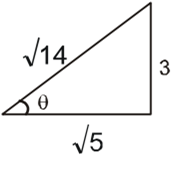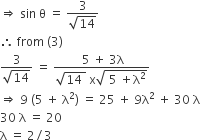 Multiple Choice Questions
Multiple Choice QuestionsLet I be the purchase value of an equipment and V(t) be the value after it has been used for t years. The value V(t) depreciates at a rate given by differential equationd V(t)/dt = - k(T - t), where k > 0 is a constant and T is the total life in years of the equipment. Then the scrap value V(T) of the equipment is




For x ∈, (0, 5π/2) define f(x). Then f (x) =  has
has
local maximum at π and 2π.
local minimum at π and 2π
local minimum at π and the local maximum at 2π.
local minimum at π and the local maximum at 2π.
The area of the region enclosed by the curves y = x, x = e, y =1/x and the positive x-axis is
1/2 square units
1 square units
3/2 square units
3/2 square units
The line L1: y = x = 0 and L2: 2x + y = 0 intersect the line L3: y + 2 = 0 at P and Q respectively. The bisectorof the acute angle between L1 and L2 intersects L3 at R.
Statement-1: The ratio PR: RQ equals 2√2:√5
Statement-2: In any triangle, the bisector of an angle divides the triangle into two similar triangles.
Statement-1 is true, Statement-2 is true ; Statement-2 is correct explanation for Statement-1
Statement-1 is true, Statement-2 is true ; Statement-2 is not a correct explanation for Statement-1
Statement-1 is true, Statement-2 is false
Statement-1 is true, Statement-2 is false
If the angle between the line x = and the plane x + 2y + 3z = 4 is cos-1
and the plane x + 2y + 3z = 4 is cos-1  then λ equal
then λ equal
2/3
3/2
2/5
2/5
A.
2/3

Angle between the line and plane is
But given that angle between line and plane is


Statement-1: The number of ways of distributing 10 identical balls in 4 distinct boxes such that no box is empty is 9C3
Statement-2: The number of ways of choosing any 3 places from 9 different places is 9C3 .
Statement-1 is true, Statement-2 is true; Statement-2 is a correct explanation for Statement-1.
Statement-1 is true, Statement-2 is true; Statement-2 is not a correct explanation for Statement-1.
Statement-1 is true, Statement-2 is false.
Statement-1 is true, Statement-2 is false.
If C and D are two events such that C ⊂ D and P(D) ≠0, then the correct statement among the following is:
P(C|D) = P(C)
P(C|D) ≥ P(C)
P(C|D) < P(C)
P(C|D) < P(C)
The vector  are not perpendicular and
are not perpendicular and  are two vectors satisfying:
are two vectors satisfying:  The vector
The vector  is equal to
is equal to




Statement-1 : The point A(1, 0, 7) is the mirror image of the point B(1, 6, 3) in the line: 
Statement-2: The line: bisects the line segment joining A(1, 0, 7) and B(1, 6, 3).
bisects the line segment joining A(1, 0, 7) and B(1, 6, 3).
Statement-1 is true, Statement-2 is true; Statement-2 is a correct explanation for Statement-1.
Statement-1 is true, Statement-2 is true; Statement-2 is not a correct explanation for Statement-1.
Statement-1 is true, Statement-2 is false.
Statement-1 is true, Statement-2 is false.
